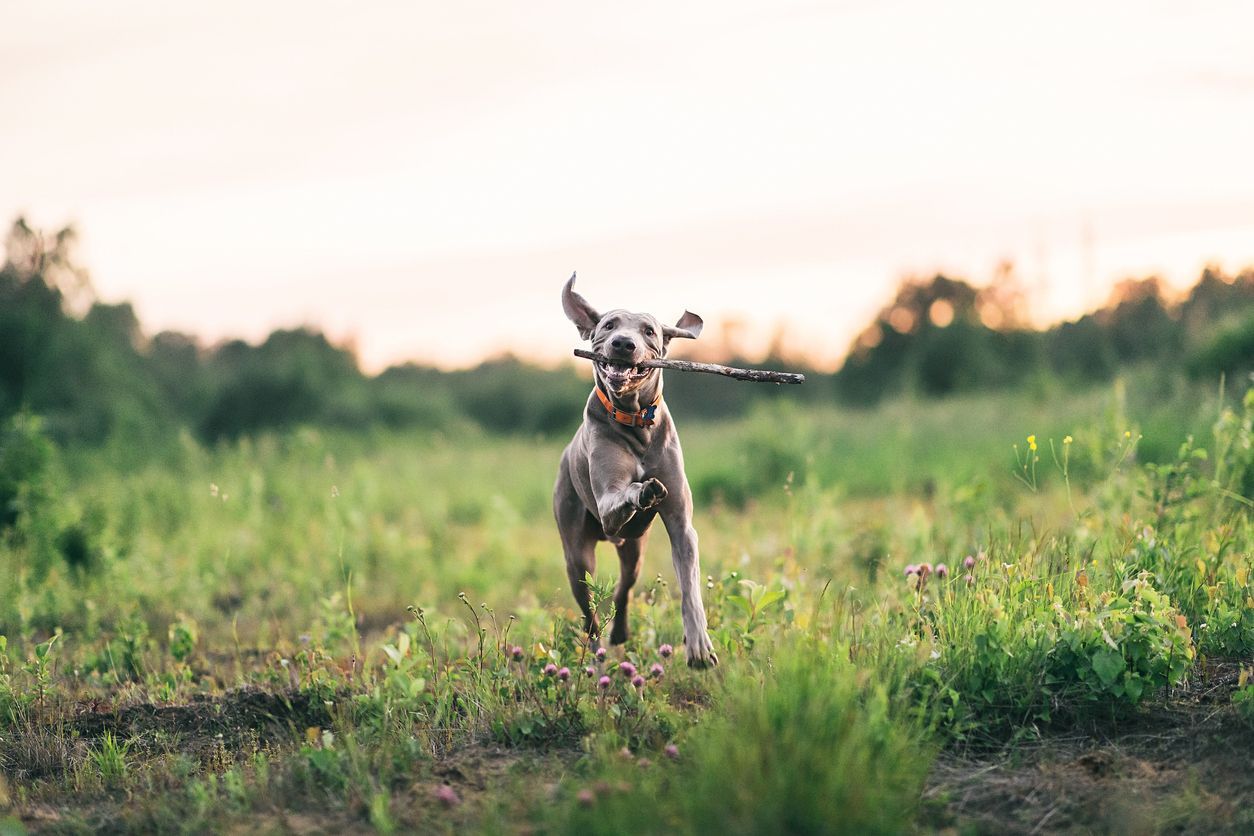Common outdoor hazards for your dog

Enjoying the outdoors with your dog whether on a hike, in your yard, or at the park are fun ways to connect with your furry friend while providing plenty of exercise for both of you. However, there are some dangers for dogs that can be found outside, even in your backyard, that dog owners should be aware of. Read on to learn:
- Can my dog catch infectious diseases outside?
- What toxic plants might be in my yard?
- If I treat my yard, does my dog need flea prevention?
- What danger from wildlife can my dog encounter?
- When is it too hot or too cold outdoors for my dog?
One of the best parts of dog ownership is playing a game of fetch or simply enjoying the nice weather outside with your dog. Backyards are sure to be safe as long as you have taken the right precautions, armed yourself with important knowledge about outdoor hazards, and are keeping a close eye on your dog. When dogs do get into something they are not supposed to, knowing what risks are present in your yard will help you get your dog the treatment they need quickly.
What infectious diseases can dogs be exposed to outdoors?
Infectious diseases can be spread to your dog from other dogs and wildlife. Diseases can be transmitted through the air or from feces or urine of other animals, as well as insect bites.
Infectious diseases between dogs
Dogs can easily spread diseases between each other through physical contact or exposure to bodily fluids in the air or on the ground. Parvovirus, bordetella, and canine distemper are a few examples of diseases dogs can spread to each other. Many of these diseases can be prevented through routine vaccinations.
Infectious diseases from other wild animals
Wildlife living in your area can also spread disease to your dog. Leptospirosis is shed in the urine of an infected animal, and dogs are exposed when they drink from ponds or puddles where runoff collects. Rabies, though less common, is spread by bites from infected animals, and raccoon, skunks, bats, and foxes are important wildlife reservoirs for this disease.
Infectious diseases from insects and pests
Mosquitos, fleas, and ticks can spread internal parasites and infectious diseases. Tapeworms, heartworms, and tick-borne illnesses like Lyme disease are examples of diseases that can be transmitted to dogs by insects and other external parasites. “Insects are more abundant outdoors but can easily come inside as well,” states Dr. Jo Myers. “All dogs, no matter how often they go outdoors, should use year-round flea, tick, and heartworm prevention to stay safe.”
Are there plants in my yard that are toxic for my dog?
Many common plants are toxic to dogs when ingested. Many of these poisonous plants are decorative, such as sago palms, foxglove, and castor beans. Other plants, such as decorative flowers with bulbs, pose risks for foreign body GI obstruction when ingested. Finally, some grass seeds can be irritating and cause injury, such as foxtails. If you are unsure what plants are toxic in your area, the ASPCA has a full list of plants toxic to dogs ranging in their levels of danger.
Are lawn treatments safe for dogs?
Playing a game of fetch or running around the yard is a normal part of dog ownership. However, lawn treatments do pose some hazards for dogs that pet owners should be aware of. Fertilizers, herbicides, and insecticides can contain dangerous chemicals that harm dogs when ingested, inhaled, or absorbed through the skin. Dogs can accidentally ingest these chemicals by eating grass, grooming themselves after playing in treated grass, or drinking runoff water from the yard. If your dog must play on a treated lawn, be sure to stay off the grass for the amount of time specified by the company that treated the lawn.
Is my garden safe for my dog?
If your dog enjoys relaxing with you in the garden, there are a few hazards to watch out for as you enjoy your time together. Rodent poisons and baits, as well as insecticides, may be toxic when ingested. If these items are used in your garden, keep them out of reach of your dog. Cocoa mulch is made from the husks of the cocoa plant and can cause the same toxicity in dogs as chocolate if ingested in sufficient quantities.
Sharp objects like shears can cause injury if they are not put away properly. Finally, keep decorative rocks or gravel away from dogs who may enjoy chewing on them, as they can cause intestinal blockage that will need to be treated with surgery. Many dogs also enjoy rolling around and digging in the dirt. Depending on where you live and what wildlife is around your home, some dirt can contain harmful fungi and parasites.
Should my dog be on flea and tick preventative if my yard is treated?
Treating your yard for fleas and ticks may help reduce your dog’s exposure to these pests, but does not eliminate it. The chemicals in yard treatments may also increase your dog's risks for some types of cancer. Since fleas, ticks, and mosquitoes can spread life-threatening diseases, such as Lyme and heartworm disease, it’s best to keep your pet on flea and tick prevention year-round instead of relying on treating your yard.
What about internal parasites in dogs?
Some internal parasites are spread by mosquitoes and fleas, so prevention is best to keep your dog safe from internal parasites. Heartworm disease is becoming an increasingly widespread risk to dogs and can only be prevented with prescription heartworm preventative. Other parasites can be spread from other animals or found on the ground and in water sources, including giardia, whipworms, and roundworms. Fecal tests at your dog’s annual wellness exam can show evidence of some of these parasites early and treat them before they become out of hand. If your dog experiences sudden or prolonged diarrhea, a fecal test from your vet may be warranted to rule out internal parasites.
Are there potential dangers with nearby wildlife for my dog?
In addition to transmitting infectious diseases, animals commonly found around residential areas, including raccoons, skunks, porcupines, badgers, and coyotes, can injure dogs. In areas that have venomous snakes and spiders, dogs can be at risk for serious bites and stings as well.
Is it too hot or cold outside for my dog?
A general rule of thumb is that if it is too hot or cold outside for you, it is too hot or cold for your dog. However, some dogs are more sensitive to heat or cold than others. Dogs with flat faces or those who are overweight can be more sensitive to heat. Cold-loving dogs, such as Huskies, Great Pyrenees, Saint Bernards, and Malamutes, often enjoy the cold but are more sensitive to the heat.
Extreme cold
Extreme cold can cause hypothermia and frostbite in dogs. In addition, when it is cold outside, toxic chemicals are often around, such as antifreeze in cars and pavement salt. Salt on the ground to stop ice from forming can also cause burns on paw pads if your dog’s feet are exposed.
Extreme heat
High temperatures put dogs at risk for hyperthermia and heat stroke. Dogs are most likely to experience heat-related illnesses if they are trapped somewhere they cannot escape, such as a locked car or garage, or if motivated to exercise, work outdoors, or participate in strenuous activities in the heat. Hot pavement can cause serious burns on paw pads. When going on walks in the summer, avoid direct sunlight and pavement, choosing shady areas with grass when possible. Always offer plenty of fresh water before, during, and after your walk to keep your dog hydrated and cool.
What potential hazards for my dog could be in my backyard?
While this list is not exhaustive, there are many common hazards for dogs who enjoy outdoor time. Risks include:
- Diseases spread by other dogs, wildlife, and insects
- Toxic or hazardous plants
- Exposure to intestinal parasites through insects, infected feces, or wildlife
- Toxic chemicals in lawn treatments, pesticides, herbicides, and rodenticides
- Extreme heat or extreme cold outdoor temperatures
When dogs are closely monitored and hazards are kept out of reach, outdoor adventures can be a great source of exercise and enrichment. If you have questions about what is safe and unsafe around your yard and neighborhood for your dog, you can speak to an online vet today.
FAQ - Common outdoor hazards for your dog
What in my backyard can make my dog sick?
Infectious diseases spread by other dogs and wildlife, and bites from fleas, ticks, and mosquitoes are common outdoor hazards for dogs. Examples of other backyard risks include chemicals used in lawn treatments and pesticides. The risks associated with some outdoor hazards can be minimized by keeping vaccinations and parasite prevention up to date. Keeping lawn treatments to a minimum or switching to alternatives that use fewer toxic ingredients can also limit exposure.
Can I treat my yard safely around my dog?
Yard treatments often contain pesticides, herbicides, and fertilizers that can be toxic to dogs when inhaled, ingested, or absorbed through the skin. If you decide to treat your yard, keep it to a minimum and prevent your dog from playing in the yard or around any runoff. Some alternative treatments use fewer toxic ingredients that you can switch to.
How long can you leave a dog outside?
Every dog’s ability to tolerate heat and cold is different. Very young and old dogs, dogs with chronic illnesses, and flat-faced dogs are at increased risk from exposure to extreme temperatures. Watch your dog for signs of fatigue or discomfort if it is hot or cold outside. If you are uncomfortable outside, your dog might be too.




